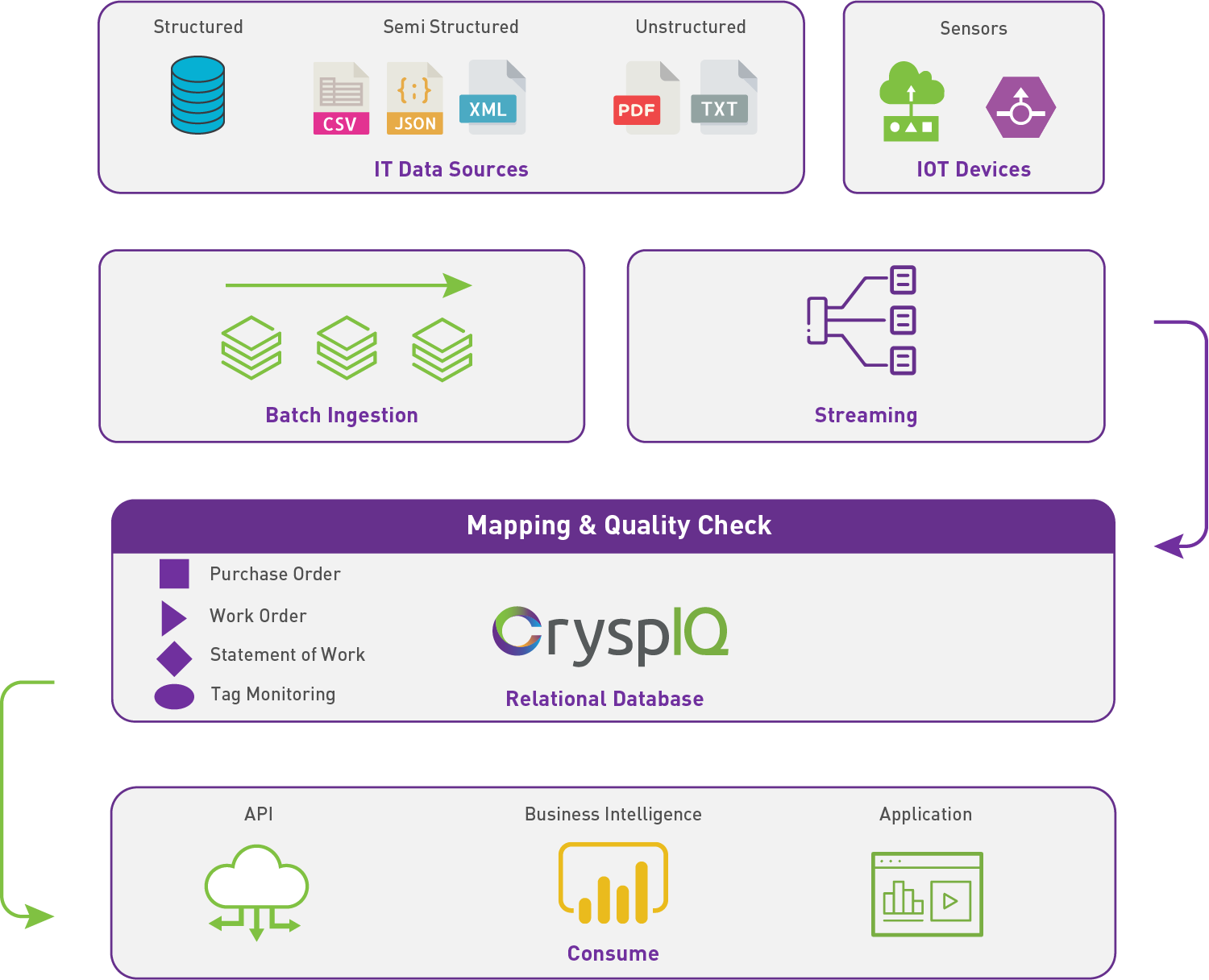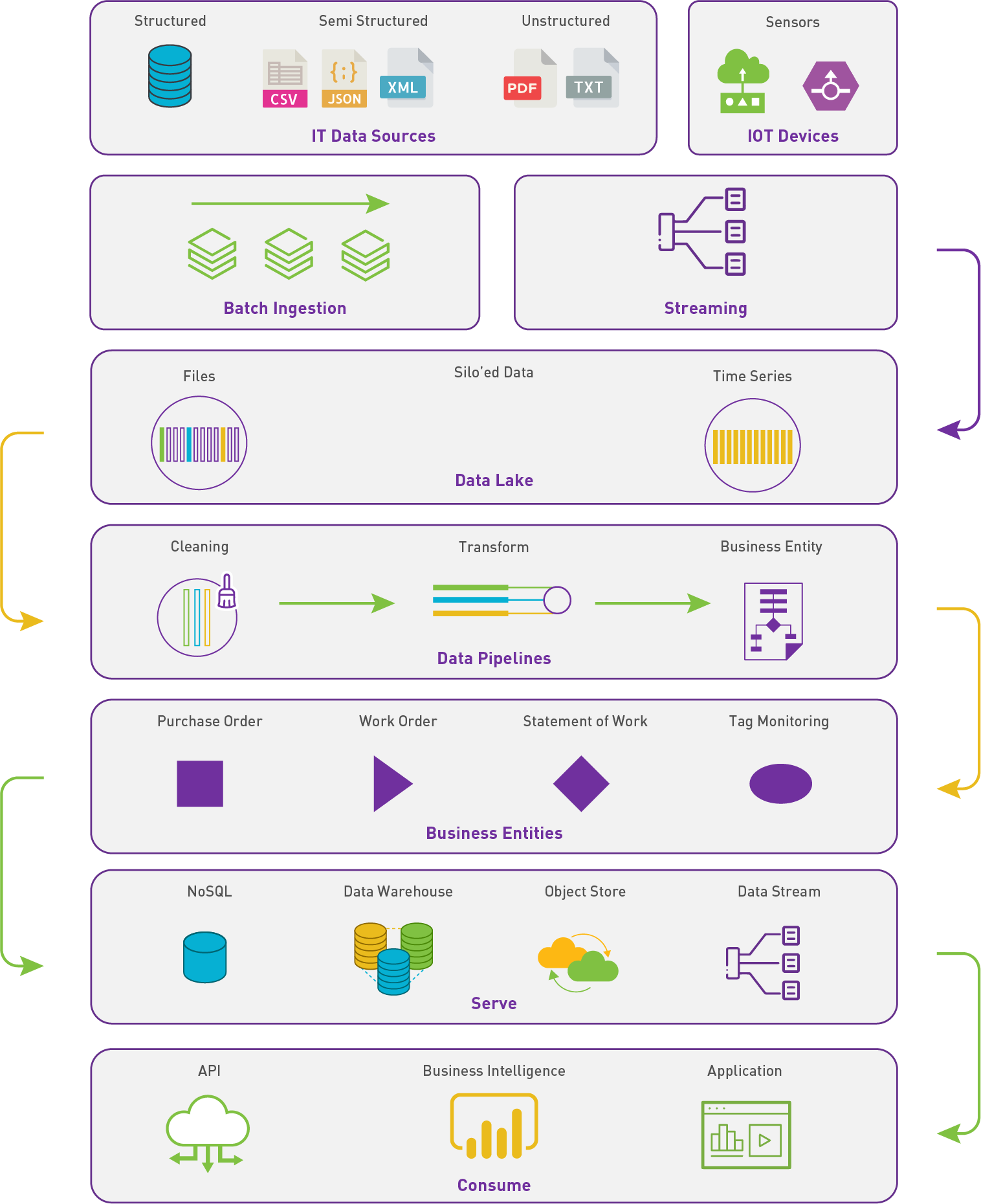Comparisons
To compare CryspIQ® to other industry methodologies and market products, it is necessary look at the method and solution separately. These comparisons are provided below.
Industry Methodologies
Data Warehousing methods refer to architectural designs and structures used to organise and manage Data across an enterprise. These models determine how data is stored, accessed and used for analytical and AI purposes.
Methodology Definitions
The data warehousing methodologies are described below:
- Bill Inmon - Method is the top-down or data-driven strategy, in which we start with the data warehouse and break it down into data marts.
- Ralph Kimball - Method is the bottom-up approach where data marts are first created to provide reporting and analytical capabilities for a function.
- Data Lake - Method is storing data within a system or repository, in its natural format, that facilitates the collation of data in object blobs or files.
- Data Vault 2.0 - Method is designed to provide long-term historical storage of data coming in from multiple operational systems.
- CryspIQ® - Method is the decomposition of source records to allow storage of the incoming data at a granular level clustered with data of like type.
Compare Methodologies
To compare CryspIQ® against other methodologies, please see table below:
| Function | CryspIQ® | Kimball | Inmon | Data Lake | Data Vault |
|---|---|---|---|---|---|
| Single source of truth across functions | ✅ | ❌ | ✅ | ❌ | ❌ |
| Data modelling skills | ❌ | ✅ | ✅ | ✅ | ✅ |
| Source system dependency | Flexible | Inflexible | Inflexible | Flexible | Flexible |
| Upfront effort | Low | Medium | High | Low | medium |
| Low technical dependency | ✅ | ❌ | ❌ | ✅ | ❌ |
| Speed to value | Fast | Medium | Slow | Fast | Medium |
| Training | ✅ | ✅ | ✅ | ❌ | ✅ |
| Scalability | ✅ | ❌ | ❌ | ❌ | ✅ |
| Change impacts | Low | Medium | High | Low | High |
| Lineage & traceability | Automatic | Manual | Manual | Manual | Manual |
| Data consistency | ✅ | ❌ | ✅ | ❌ | ✅ |
Compare Cloud Data Toolsets
CryspIQ® provides an end to end data fabric solution in a single toolset. We have provided a comparison against the most common cloud data solutions used in the market. Please note that CryspIQ® can co-exist with your existing Enterprise Data Platform (EDP). These are shown the table below:
| Function | CryspIQ® | Databricks | Snowflake | AWS | Microsoft | |
|---|---|---|---|---|---|---|
| Data governance for AI | ✅ | ❌ | ❌ | ❌ | ❌ | ❌ |
| No AI model retraining | ✅ | ❌ | ❌ | ❌ | ❌ | ❌ |
| Static data model | ✅ | ❌ | ❌ | ❌ | ❌ | ❌ |
| Master data unification | ✅ | ❌ | ❌ | ❌ | ❌ | ❌ |
| Store only relevant data | ✅ | ❌ | ❌ | ❌ | ❌ | ❌ |
| Small data footprint | ✅ | ❌ | ❌ | ❌ | ❌ | ❌ |
| In-built data quality | ✅ | ❌ | ❌ | ❌ | ❌ | ❌ |
| Low application change impacts* | ✅ | ❌ | ❌ | ❌ | ❌ | ❌ |
| IT / OT data modelled** | ✅ | ❌ | ❌ | ❌ | ❌ | ❌ |
| Self-service (No modelling) | ✅ | ❌ | ❌ | ❌ | ❌ | ❌ |
| Multi-cloud | ✅ | ✅ | ✅ | ❌ | ❌ | ❌ |
| Unstructured data | ✅ | ✅ | ❌ | ❌ | ❌ | ❌ |
Please note:
*This refers to impacts when changing out source applications / technologies. There is a high cost for end to end rebuilds or model re-training.
**This refers to both IT / OT data (Sensor or time series data) being stored in the same database schema and modelled ready for analytical purposes.
Compare End to End Solutions
The key difference between the CryspIQ® and traditional solutions is the number or layers involved in making the data ready for analytics. Traditional solutions normally have approximately three layers before the data is made available to the end user, whereas CryspIQ® has one. These difference are shown below in the diagrams.
The CryspIQ® Solution
The CryspIQ® solution collapses the layers to measure quality at the point of entry, adds contextual metadata in flight and reduces the failure points in the processing of data. CryspIQ® provides self service to all people across your organisation regardless of technical knowledge and capability. Ongoing support of the solutuon does not require specialist technical resources to untangle and makes sense of your data.
In the CryspIQ® world, you have:
- a technical toolset that manages a single layer for your data.
- the same technical toolset that conducts live data quality checks on your data.
- the same technical toolset that transforms or prepares your data for visualisation.
- the same technical toolset that catalogues your data.
- the same technical toolset that provides self-service to all your data.
Result - You have 1 Licensing cost for all functional components.
This is demonstrated in the diagram below:

The Traditional Solution
Traditional data warehouse solutions are normally made up of a number layers. Each layer introduces a failure point in the processing and management of data. In most cases, there is a staging layer, a transform layer and visualisation layer. Data products are curated and presented in the visualisation layer to users for analytics. This creates a dependency on specialist technical resources to prepare and curate the data to create a data product. Please note that this is still an intepretation of what the technology team has from the requirements. Ongoing support requires specialist technical resources.
In the traditional world, you have:
- a technical toolset to manage all the layers for your data.
- a different technical toolset to conduct adhoc data quality checks.
- a different technical toolset to transform or prepare your data for the visualisation layer.
- a different technical toolset to catalogue your data.
- a different technical toolset to provides self-service to the intepreted data products.
Result - You have 5 different Licensing costs for each functional component.
This is shown the diagram below:
